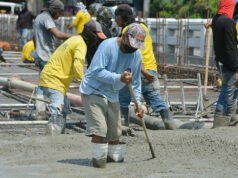Peso inches higher on soft US economic reports

THE PESO extended its rise on Thursday to hit a new near five-month high against the dollar as concerns over a slowing US economy following softer data recently continued to weigh on the greenback.
The local unit closed at P57.32 per dollar on Thursday, inching up by 2.5 centavos from its P57.345 finish on Wednesday, Bankers Association of the Philippines data showed.
This was the peso’s best finish in nearly five months or since its P57.205-a-dollar close on Oct. 11, 2024.
The peso opened Thursday’s session stronger at P57.25 against the dollar. It climbed to a high of P57.12 during the day, while its intraday low was at P57.333 versus the greenback.
Dollars exchanged inched down to $1.52 billion from $1.55 billion on Wednesday.
“The peso followed regional currencies amid a weaker dollar due to concerns of a weaker US economy after softer ADP, ISM (Institute for Supply Management) services, and GDP (gross domestic product) data,” the first trader said in a phone interview.
US services sector growth unexpectedly picked up in February and prices for inputs increased, which combined with a recent surge in the cost of raw materials at factories suggested that inflation could heat up in the months ahead, Reuters reported.
Rising price pressures could be worsened by a trade war, triggered by President Donald J. Trump’s new 25% tariffs on imports from Mexico and Canada, which took effect on Tuesday, along with a doubling of duties on Chinese goods to 20%.
The ISM survey on Wednesday showed tariffs widely mentioned in comments, with some industries saying the levies had “created chaos” and “great uncertainty about future business activity.”
Deep federal government spending cuts also worried business, suggesting that activity could ease in the months ahead. The combination of high inflation and slowing economic growth could paint the Federal Reserve into a corner.
The ISM’s non-manufacturing purchasing managers index (PMI) climbed to 53.5 last month from 52.8 in January. Economists polled by Reuters had forecast the services PMI dipping to 52.6.
A PMI reading above 50 indicates growth in the services sector, which accounts for more than two-thirds of the economy.
The ISM associates a PMI reading above 49 over time with expansion in the overall economy. The PMI pointed to resilience in domestic demand, but was at odds with so-called hard data, including consumer spending and homebuilding that have suggested a sharp slowdown in gross domestic product this quarter.
With the goods trade deficit deteriorating sharply in January, largely blamed on front-loading of imports ahead of tariffs, the Atlanta Fed is currently forecasting GDP contracting at a 2.8% annualized rate this quarter. The economy grew at a 2.3% pace in the fourth quarter.
The dollar fell against a basket of currencies.
Separately, the ADP National Employment Report showed payrolls increased by 77,000 jobs in February, the smallest gain since July 2024, after rising 186,000 in January. Economists had forecast private employment advancing 140,000.
The ADP report, jointly developed with the Stanford Digital Economy Lab, likely exaggerates the labor market slowdown and has no correlation with the government’s employment report.
Nonfarm payrolls are estimated to have increased by 160,000 jobs after rising 143,000 in January, a Reuters survey showed. The unemployment rate is forecast unchanged at 4.0%.
“The peso was mostly sideways but ended lower following reports of a Russian attack against Ukraine after hitting fresh lows of P57.12,” the second trader said in a phone interview.
For Friday, the first trader expects the peso to move between P57.15 and P57.55 per dollar, while the second trader sees it ranging from P57.10 and P57.50. — Aaron Michael C. Sy with Reuters



